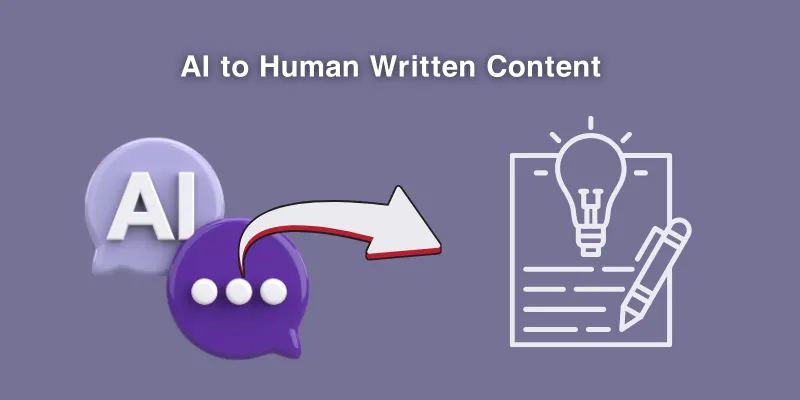How to Add Personal Touch in AI Written Content
Published: 16 Aug 2025
AI writing tools have changed the way we create content in almost every industry. They make the writing process faster and more efficient than ever before. However, AI content often feels flat and lacks the unique spark of a human voice. That is why learning how to add a personal touch to AI-written content has become so important today. Adding your style and personality can make AI-generated text warm, relatable, and engaging. It can also help you build stronger connections with your audience.
Why AI Content Often Feels Robotic
AI tools follow patterns based on the data they are trained on. They can produce clear sentences, but they cannot feel emotions like a human. Because of this, AI text often sounds generic and predictable to the reader. It may also miss the natural flow and storytelling style that humans use. Without personal touches, the writing can feel like it came from a machine rather than a real person. That is why editing AI content with a human touch is key to making it more engaging.
The Role of a Personal Touch in Content
A personal touch in writing means adding your unique voice, opinions, and experiences. It is what makes your content stand out from thousands of similar pieces online. When you add personal elements, readers feel like they are hearing from a real person. This builds trust and keeps your audience interested in what you have to say. A strong brand voice also helps people remember you and come back for more content.

Understand Your Audience First
You cannot make content personal if you do not know who you are talking to. Start by understanding the needs, problems, and interests of your audience. For example, a business blog for young entrepreneurs will have a different tone than a blog for teachers. You can learn about your audience by reading their comments, checking their questions, or running short polls. When you know your readers well, you can choose examples and words they will connect with instantly.
Add Real-Life Experiences and Examples
Sharing personal experiences is one of the easiest ways to humanize AI content. Tell short stories about moments that relate to your topic. If you are writing about productivity, share a day when you struggled to focus and how you fixed it. You can also use customer success stories to make your point stronger. Real-life examples make your content relatable and help readers trust your advice.
Use a Conversational Tone
A conversational tone makes readers feel like you are speaking directly to them. Write in a way that sounds like a friendly discussion instead of a formal lecture. Keep your sentences short and straightforward, avoiding heavy or complex structures. For example, instead of saying “The optimization of productivity can be achieved through time management,” you can say “You can get more done by managing your time well.” This small change makes your writing sound warm and natural.
Infuse Your Opinions and Insights
AI is excellent at gathering facts, but it cannot share your viewpoint. Adding your own opinions makes the content unique and shows your expertise. For example, if AI writes “Email marketing is effective,” you can expand by saying “I believe email marketing works best when you treat it like a personal conversation.” This extra insight separates your content from standard AI text.
Include Cultural References Where Relevant
If your audience shares a culture or background, small references can make the content more engaging. Mentioning familiar traditions, trends, or events helps readers connect instantly. For example, if you are writing for Pakistani readers, you might reference Eid celebrations when talking about community spirit. These details make the writing feel more alive and relevant to the audience.
Adjust Formatting for Readability
Even great content can lose readers if it looks overwhelming. Break your writing into short paragraphs so it is easier to scan. Use clear headings and subheadings to guide the reader through the content. Highlight important points with bold text so they stand out. Readable formatting shows respect for your reader’s time and attention.
Edit AI Content Like a Human Editor
Never publish AI text without reviewing it first. Read it aloud to check if it sounds natural and easy to follow. Replace awkward or repetitive phrases with fresh, human-sounding sentences. Add emotional triggers, such as words that make people feel inspired or curious. Good editing turns a robotic draft into something warm and inviting.
Maintain Brand Voice Across All Content
Your brand voice is how your audience recognizes you in a crowded space. Decide whether your tone should be formal, friendly, bold, or playful. Once you set this tone, use it in all your blog posts, emails, and social media content. This consistency helps you build a strong identity that AI alone cannot create.
Common Mistakes to Avoid When Personalizing AI Content
One mistake is adding too many personal details that distract from the main message. Another is shifting the tone so much that the content no longer matches your audience’s expectations. Avoid making the style too casual if your readers expect a professional approach. Strike a balance between personality and clarity to keep your main point strong.
Tools and Techniques to Make AI Content More Personal
When giving AI a prompt, be specific about the tone, style, and audience you want. Ask it to include examples, humor, or emotional language where appropriate. After AI produces the text, incorporate your sentences and revise sections to match your voice. Using rephrasing tools can also help make sentences sound more natural.
Final Tips for Balancing AI Efficiency and Human Warmth
AI saves time by producing first drafts quickly. Your job is to blend that speed with your creativity and insights. Keep adding fresh ideas, stories, and examples to make the content unique. This combination lets you enjoy the benefits of AI without losing the human touch.
SEO content writing service helps businesses create content that ranks higher on search engines. These services focus on using the right keywords, clear structure, and engaging language. The goal is to attract the right audience and turn readers into customers.
Conclusion
Adding a personal touch to AI-written content is not about replacing the technology. It is about enhancing it with your personality, voice, and experience. When you do this, your content becomes more relatable, memorable, and impactful. Begin with small changes, such as adding stories, using a conversational tone, and sharing your opinions. Over time, you will develop a style that makes your AI content stand out and truly connect with your audience.
FAQ
You can make AI writing look human by adding personal stories and real-life examples. Use a conversational tone with short and clear sentences. Edit the text to remove repetitive or robotic phrases. Include emotions, opinions, and cultural references that your audience understands. Finally, read the content aloud to ensure it flows naturally.
There is no single AI tool that can fully replace a human touch in writing. However, tools like Grammarly, Jasper, and Copy.ai can help improve tone and readability. These tools suggest ways to make text more friendly and engaging. Still, your personality, opinions, and stories make the biggest difference. Think of AI tools as helpers, not replacements, for adding a human feel.
Begin by providing ChatGPT with a clear prompt that includes tone and style instructions. After it creates the draft, add your insights and examples. Adjust words and sentences so they sound natural when spoken aloud. Replace overly formal or robotic phrases with warm, relatable ones. Always review the final text to match your audience’s needs and expectations.
AI-friendly content is content that is clear, structured, and easy for AI to understand and process. Use short paragraphs, proper headings, and simple vocabulary. Avoid complex sentence structures and unnecessary jargon. Make sure your ideas are well-organized and easy to follow. This not only helps AI generate better outputs but also improves readability for humans.

- Be Respectful
- Stay Relevant
- Stay Positive
- True Feedback
- Encourage Discussion
- Avoid Spamming
- No Fake News
- Don't Copy-Paste
- No Personal Attacks

- Be Respectful
- Stay Relevant
- Stay Positive
- True Feedback
- Encourage Discussion
- Avoid Spamming
- No Fake News
- Don't Copy-Paste
- No Personal Attacks



